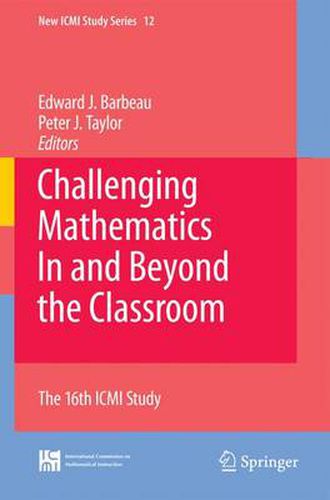Readings Newsletter
Become a Readings Member to make your shopping experience even easier.
Sign in or sign up for free!
You’re not far away from qualifying for FREE standard shipping within Australia
You’ve qualified for FREE standard shipping within Australia
The cart is loading…






This title is printed to order. This book may have been self-published. If so, we cannot guarantee the quality of the content. In the main most books will have gone through the editing process however some may not. We therefore suggest that you be aware of this before ordering this book. If in doubt check either the author or publisher’s details as we are unable to accept any returns unless they are faulty. Please contact us if you have any questions.
In the mid 1980s, the International Commission on Mathematical Instruction (ICMI) inaugurated a series of studies in mathematics education by comm- sioning one on the influence of technology and informatics on mathematics and its teaching. These studies are designed to thoroughly explore topics of c- temporary interest, by gathering together a group of experts who prepare a Study Volume that provides a considered assessment of the current state and a guide to further developments. Studies have embraced a range of issues, some central, such as the teaching of algebra, some closely related, such as the impact of history and psychology, and some looking at mathematics education from a particular perspective, such as cultural differences between East and West. These studies have been commissioned at the rate of about one per year. Once the ICMI Executive decides on the topic, one or two chairs are selected and then, in consultation with them, an International Program Committee (IPC) of about 12 experts is formed. The IPC then meets and prepares a Discussion Document that sets forth the issues and invites interested parties to submit papers. These papers are the basis for invitations to a Study Conference, at which the various dimensions of the topic are explored and a book, the Study Volume, is sketched out. The book is then put together in collaboration, mainly using electronic communication. The entire process typically takes about six years.
$9.00 standard shipping within Australia
FREE standard shipping within Australia for orders over $100.00
Express & International shipping calculated at checkout
This title is printed to order. This book may have been self-published. If so, we cannot guarantee the quality of the content. In the main most books will have gone through the editing process however some may not. We therefore suggest that you be aware of this before ordering this book. If in doubt check either the author or publisher’s details as we are unable to accept any returns unless they are faulty. Please contact us if you have any questions.
In the mid 1980s, the International Commission on Mathematical Instruction (ICMI) inaugurated a series of studies in mathematics education by comm- sioning one on the influence of technology and informatics on mathematics and its teaching. These studies are designed to thoroughly explore topics of c- temporary interest, by gathering together a group of experts who prepare a Study Volume that provides a considered assessment of the current state and a guide to further developments. Studies have embraced a range of issues, some central, such as the teaching of algebra, some closely related, such as the impact of history and psychology, and some looking at mathematics education from a particular perspective, such as cultural differences between East and West. These studies have been commissioned at the rate of about one per year. Once the ICMI Executive decides on the topic, one or two chairs are selected and then, in consultation with them, an International Program Committee (IPC) of about 12 experts is formed. The IPC then meets and prepares a Discussion Document that sets forth the issues and invites interested parties to submit papers. These papers are the basis for invitations to a Study Conference, at which the various dimensions of the topic are explored and a book, the Study Volume, is sketched out. The book is then put together in collaboration, mainly using electronic communication. The entire process typically takes about six years.